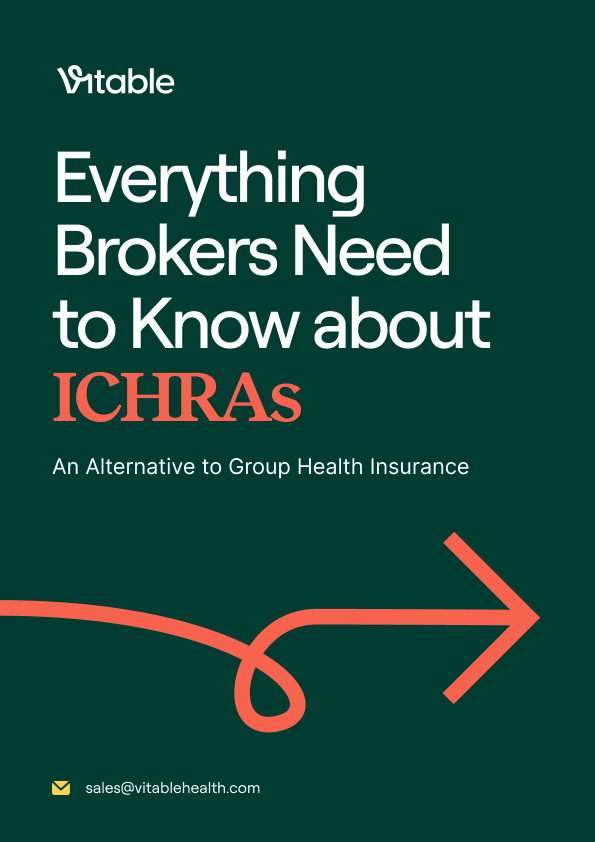What are Ancillary Benefits?

Today, employees are paying closer attention to the health benefits offered by potential employers, and they’re looking for more than just medical coverage. Ancillary benefits, such as vision and dental care, have become top priorities for job seekers, especially as the cost of routine care continues to increase.
While ancillary benefits are often viewed as “extras,” they can have a big impact on employee satisfaction, retention, and overall well-being. For employers, they can represent a cost-effective way to enhance your benefits offering and stay competitive in a challenging hiring market.
In this article, we’ll break down what ancillary benefits are, why they matter, and how focusing on high-impact options like dental and vision can help you build a better benefits package for your team.
What are Ancillary Benefits?
Ancillary benefits are supplemental health benefits that cover miscellaneous additional medical expenses not covered by a major medical plan. Ancillary benefits help fill gaps in traditional insurance plans by covering services that employees still use regularly, like eye exams, dental cleanings, and even income protection in the case of disability. Unlike major medical coverage, ancillary benefits are often optional or customizable. This gives employers flexibility in what they offer and how they offer it. And for employees, these benefit options provide access to care that supports everyday health, often at a lower cost than paying out of pocket.
Examples of Ancillary Benefits
Ancillary benefits can be offered in addition to primary health insurance plans. Employers can include various types of coverage, depending on the needs of their workforce. Below are some of the more common ancillary benefit types:
Dental Insurance
Covers preventive services like routine cleanings, exams, and x-rays, as well as basic procedures such as fillings and extractions. Many plans also offer partial coverage for more advanced care, such as root canals, oral surgery, and orthodontics (including braces or aligners).
Vision Insurance
Typically includes annual eye exams, prescription lenses, frames, and contact lenses. Some plans also cover screenings and discounts for conditions like glaucoma, macular degeneration, or astigmatism, which can impact long-term eye health.
Short- and Long-Term Disability Insurance
Provides income protection if an employee becomes temporarily or permanently unable to work due to illness, injury, or other qualifying conditions. Short-term disability usually covers a few weeks to months, while long-term disability can extend coverage for years or until retirement, depending on the plan.
Life Insurance
Pays a lump sum to an employee’s chosen beneficiaries in the event of their death. This benefit helps provide financial stability for a surviving spouse, children, or dependents and is often seen as a foundational part of a comprehensive benefits package.
Health Savings Accounts (HSAs)
Tax-advantaged savings accounts that employees can use to pay for qualified medical expenses. HSAs are typically paired with high-deductible health plans (HDHPs) and allow funds to roll over year to year. Employees and employers can both contribute, and funds can be invested for long-term savings.
Flexible Spending Accounts (FSAs)
FSAs allow employees to set aside pre-tax income to cover out-of-pocket medical expenses like copays, prescriptions, and some over-the-counter items. Unlike HSAs, FSAs are usually “use it or lose it” accounts, meaning unused funds do not roll over into the next year.
Additional Offerings (Less Common but Growing in Popularity)
Some businesses offer more specialized ancillary benefits based on the needs of their team. These may include:
- Wellness Programs: Incentives for healthy behavior, such as step challenges, gym memberships, smoking cessation support, or nutrition coaching
- Behavioral Health Services: Access to therapy, counseling, or stress management tools (e.g., an Employee Assistance Program or virtual mental health support)
- Fertility Support: Coverage for fertility treatments, egg freezing, or IVF, often with care navigation services
- Family-Building Benefits: Assistance with adoption fees, surrogacy support, or paid leave policies for growing families
- Elder Care: Services like caregiver support, referrals for elder care facilities, or paid time off to care for aging parents
- Pet Insurance: Helps cover unexpected vet bills, surgeries, or chronic condition management for employees' furry family members
Why Ancillary Benefits Are Good for Business
In the U.S., employees rely heavily on employer-sponsored health insurance, not just for primary care, but also for access to essential services such as dental and vision care. Without employer support, many Americans wouldn’t be able to afford the everyday healthcare they need to stay healthy, productive, and financially secure. Your employees are the driving force behind your business. They’re the ones solving problems, serving customers, and helping your company grow day after day. To stay competitive in today’s job market, offering meaningful, well-rounded benefits is no longer optional—it’s expected.
Ancillary benefits aren’t just good for your team, they’re good for your bottom line. Here's how offering benefits like dental and vision care can help your business thrive:
Attract Top Talent
Today’s job seekers evaluate benefits packages just as closely as salary and job duties. Offering ancillary benefits, especially highly-used options like vision and dental, can help your business stand out from competitors. When you’re able to attract stronger candidates, you build higher-performing teams and reduce the time and cost associated with hiring.
Decrease Employee Turnover
Replacing an employee can cost up to 1.5–2x their annual salary when you factor in recruiting, training, and lost productivity. Providing a robust benefits package helps employees feel supported and invested in their role. When people feel cared for, they’re more likely to stay, and that saves your company money while preserving institutional knowledge and momentum.
Boost Day-to-Day Productivity
Healthy employees are more engaged, focused, and effective. Ancillary benefits, such as dental and vision coverage, help your team stay ahead of potential health issues and avoid distractions caused by untreated conditions. When employees feel well, they work well, resulting in better outcomes, higher output, and improved customer experiences.
Minimize Absenteeism
Preventive care is key to reducing unplanned sick days. Vision exams can detect underlying health conditions, and regular dental care can prevent painful infections that lead to missed work. Offering these benefits helps your team stay healthy, present, and on task, reducing disruptions and keeping your business running smoothly.
Strengthen Company Culture and Brand Reputation
When you prioritize employee wellness, it shows. Ancillary benefits signal that your company values its people, not just as workers, but as humans. This boosts morale, builds trust, and cultivates a workplace culture where people want to do their best work. And when your employees are happy, your clients, customers, and community take notice.

Download 2025 Employer Guide to ICHRA
Vitable’s ICHRA Guide gives employers a clear, step-by-step resource for building smarter, ACA-compliant benefits.
This guide explains how ICHRAs work, who qualifies, and how Vitable simplifies setup, onboarding, reimbursements, and compliance — while giving employees more flexibility, control, and care.

Download Vitable’s 2025 Broker’s Guide to ICHRA
The Broker Guide to ICHRAs is a comprehensive resource that helps brokers understand, sell, and manage Individual Coverage HRAs with confidence.
This guide covers everything from compliance and class design to administration flows, case studies, and how Vitable streamlines quoting, enrollments, and reimbursements for brokers, employers, and employees.
How to Offer Ancillary Benefits Without Breaking the Bank
You don’t need a massive budget to offer meaningful benefits. Ancillary coverage can be introduced in a way that aligns with your financial goals while still supporting your team’s health and satisfaction. Most employers fund ancillary benefits through one of two models: employer-paid or employee-paid (voluntary). Understanding how each option works can help you decide what’s realistic for your business and attractive to your workforce.
Employer-Paid (Employer-Contributory) Plans
In this model, the employer pays all or part of the cost of ancillary benefits. This is one of the most common approaches, particularly among companies seeking to remain competitive in recruiting and retention.
Why this model works:
- Employees love it. Lower or no out-of-pocket costs make it more likely they’ll enroll and actually use the benefits. That means happier, healthier employees who feel valued.
- It boosts your business. Offering paid benefits can reduce turnover, support morale, and strengthen your brand as a great place to work.
How employers manage costs:
You don’t have to cover everything. Many companies choose to pay a fixed percentage, like 50% of the premium, or only cover certain benefits. Start by:
- Reviewing your budget
- Talking with a broker or benefits provider to understand plan options and costs
- Offering just one or two high-impact benefits (like dental and vision) before expanding
Employee-Paid (Voluntary) Plans
With voluntary plans, employees choose the ancillary benefits they want and pay the full premium themselves. As the employer, you make the benefits available and manage the enrollment, but you’re not responsible for covering the cost. This model is especially popular among smaller businesses or companies new to offering benefits, because it allows them to provide value without a large financial commitment. Voluntary benefits offer flexibility and access—two things employees appreciate, especially when options are tailored to their needs.
How it works:
- Employers set up benefit administration
- Employees enroll in the benefits they want
- Premiums are deducted automatically from the employee’s paychecks (pre-tax)
Benefit to the employee:
- Access to coverage they wouldn’t otherwise afford or qualify for
- Many plans are available at group rates—cheaper than what employees might find on their own
- Convenience of payroll deductions
- Tax savings through pre-tax payroll deductions (if offered through a Section 125 plan)
Can You Offer Both? Absolutely.
Many companies choose to combine these models. For example, you may cover 90% of dental and vision premiums, but offer additional coverages, such as life or disability insurance, as voluntary add-ons. This blended approach gives you more control over costs while giving employees choices based on their personal needs. It’s a flexible way to offer a more comprehensive benefits package without overspending.
How to Get Pre-Tax Savings: Section 125
Whether you're covering a portion of the premium or offering benefits on a voluntary basis, you can unlock additional savings by structuring your ancillary benefits through a Section 125 Cafeteria Plan. Section 125 of the Internal Revenue Code allows employees to pay for certain benefits, like dental, vision, disability, and life insurance, using pre-tax dollars. This setup lowers taxable income for employees and reduces payroll tax liability for employers.
How It Works:
To take advantage of these savings, you'll need to set up a Cafeteria Plan for your employees. This plan allows them to select from a menu of benefit options and have their premiums automatically deducted from their paycheck before taxes are applied.
Once the plan is in place:
- Employees choose the ancillary benefits they want
- Payroll deductions are made on a pre-tax basis
- Both employer and employee benefit from tax savings
How to Know Which Ancillary Benefits to Offer
Designing the right benefits package starts with understanding your employees’ needs and balancing those needs with what’s financially realistic for your business. Not every company will offer the same mix of benefits, and that’s okay. What matters most is offering the benefits that are most relevant, most used, and most appreciated by your team.
Here are a few key steps to help you decide which ancillary benefits make sense for your business:
- Understand what matters to your employees: Chat with your team or use surveys to figure out what they want most. Dental and vision coverage are consistently ranked among the most valued and frequently used employee benefits. These are a great starting point.
- Align with industry standards: To ensure you’re staying competitive in the market, you can take a look at what other companies in your industry are offering. Working with a trusted benefits provider can help you navigate this process.
- Think about what works for your budget: Be realistic about what you can afford to cover. Whether you choose to fully fund certain benefits or offer others as voluntary add-ons, working with a trusted benefits provider can help you evaluate plan options and find the right balance between impact and affordability.
How to Get Started
If you’re ready to start building a better benefits package for your employees, the next step is partnering with a trusted benefits provider who understands your goals and makes the process simple.
Vitable Health: Where Better Benefits Start
Vitable is the health benefits platform making healthcare better for everyday workers. We help employers deliver smarter, more accessible benefits without the high cost or complexity of traditional insurance. Our model is built for growing teams, frontline workers, and businesses that want to offer more, without overspending or overcomplicating things.
At Vitable, we believe benefits should work better and cost less. That’s why we offer a flexible solution that allows employers to build the right mix of coverage for their team, starting with high-quality primary care through our enhanced Primary Care membership and layering on essential health services.
We offer ancillary benefits designed to deliver the everyday care employees want and will actually use. These ancillary plans pair seamlessly with our flexible medical plans, providing an easy and affordable way to enhance your overall benefits package without incurring additional costs for your business.
Let’s Build Better Benefits Together
With Vitable, you don’t have to choose between affordability and quality. You get a modern, flexible solution that supports employee health and provides your team with access to the benefits they truly value.
Get connected today and let’s build a better benefits experience together.
Ready to learn more?
Stay ahead with the latest insights on healthcare, benefits, and compliance—straight to your inbox.
Get a quote
Get a personalized health benefits quote tailored to your company’s unique needs.
Vitable helps employers provide better healthcare to their employees and dependents by improving accessibility, cost, and quality.
